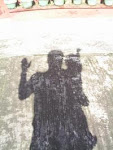

(Orihinal na nalathala ang artikulong ito sa Balikbayan Magazine na hanggang ngayon ay wala akong kopya at hindi ko rin alam kung saang talipapa bibilhin. Note sa mga larawan: ako lahat ang kumuha, gamit ang sarili kong camera, despues, akin. Siyempre maliban dun sa retrato ko na kinuhanan ni Pastor Noel Suministrado gamit ang sarili niyang camera despues, kaniya, pero may pahintulot na gamitin ko dahil pagmumukha ko ang nakabalandra.)
It is not a Baguio trip without the saccharine peanut and strawberry jam, the eternal everlasting garlands, and the stiff walis tambo; a Cebu excursion without the sodium-rich dangit and the dried tangy mangoes; a Bacolod sojourn without the flaky piaya; a Davao escapade without the flavorful scent of candy durian as signature pasalubongs. The same biyaherong Pinoy code of conduct applies to Lucban without the garlicky longganisa in tow.

But aside from munchies, why would you visit this rain-drenched town at the eastern fringe of Mount Banahaw? Topping the list of the draw is the now big-time corporate advertising event Pahiyas festival every 15th of May. This annual telecom-liquor-soy sauce sponsored affair, complete with dance contests, various product samplings, on-site noontime variety shows, and emo-rock concerts on the street, honors San Isidro Labrador, the patron saint of farmers. Pahiyas is one of Las Filipinas’ fiesta centerpieces and a haven for newby photographers who want to prove their DSLR’s mettle and their photographic eyes’ worth. To take part in the tradition and aesthetic competition, houses along the procession route are ornately designed with colorful rice crispies called kiping. Heated in medium coal-fire, kiping may be a suitable source of extra carbo after a long walk at this summer heat festivity because vehicular and humanity queue can reach full-marathon distance. Since kiping is made of rice and food color, one should not expect a grand spice explosion in crunching the razor-thin crisps that is usually molded out of a kabal leaf.
Second reason for a Lucban sortie is Kamay ni Hesus, a pilgrimage site carved out of an imposing hill beside the national highway. This two hundred plus steps of an ascending Via Crusis houses the third biggest statue of Jesus Christ in the world. Aside from the Way of the Cross and the chapel, Kamay ni Hesus is also a venue for spiritual retreats. One can wander and contemplate the magnificence of earth’s bounty, not to mention the Great Flood feel in a concrete replica of Noah’s ark turned dormitory for soul searchers. Resident healing priest, Fr. Joey Faller, heads the flock of faithfuls who seek healing of their physical, emotional, spiritual, and sometimes financial ills. During Semana Santa, the mound from afar resembles an anthill crammed with pilgrims. Traffic in Lucban during this holy occasion reaches half-marathon distance made worse by vendors that slowly inch their way to the church at the town center and at the Kamay ni Hesus grounds selling wares ranging from native hats to hammock to telescopes and bootlegged you-know-what’s. Schedule of healing masses can easily be checked at your friendly neighborhood search engines.
If Pahiyas and Kamay ni Hesus are not reasons enough to visit this thousand-plus-feet elevation of a town where a jacket and an umbrella is part of the normal get-up, then the numerous icy spring resorts is a good excuse to have a weekend stay in this place named after a citrus fruit synonymous to suha or pomelo. Just a four to five hour commute from the smoggy metro, Lucban now offers recreational and adventure facilities to the city-weary in search of cleaner air and better back drops for their social network account’s profile photos. Room rates fluctuate from a high of a thousand plus pesos—Patio Rizal Hotel at the heart of Ilaya, the town-center, and Batis Aramin resort-hotel now etched with a mountain bike trail, wall climbs, and zip line—to a few hundred bucks for rooms barely the length of an out-stretched arm and a half. Or you may want to check out and be a witness to the hostility between Tayabas’ Nawawalang Paraiso Resort and Lucban’s Natagpuang Paraiso Resort. Forget about reserving a room for a stay during Semana Santa, and worse, Pahiyas; it’s next to Azkals whacking Ronaldo and Ronaldinho's Brazil, 4-0, or Manila hosting the 2028 Olympics. Almost all rooms are reserved going to the next millennium of Pahiyas.
For adrenaline-enhanced nature trip, Lucban offers a number of waterfalls deeply entrenched in the few remaining primal flora and fauna gardens at the outskirts bordering the town of Sampaloc. For a two-hour leg-grinding butt-slamming trek, the pristine waterfalls of Maapon River is surely a generous prize for an arctic bath and a cascade of “likes” in your Facebook photo album. Just don’t forget to commission a guide or two at the barangay hall of Piis or Aliliw because challenge is an understatement for the usual slippery, criss-crossing, and sometimes quadricep-deep muddy path leading to Maapon falls. Also, you may want to immerse at the sprawling College of Forestry laboratory of Southern Luzon State University above town, the laboratory is also known by its more common name of Banahaw de Lucban. Special arrangements should be made to university authorities before scaling the protected mystical mountain where myth has it, alien crafts abound and anting-antings can be recharged like your typical consumer electronic blings.
Food-trip

You cannot mention to someone in a single breath that you have been to Lucban without citing the diet guilt-laden longganisa and pansit habhab you downed with impunity. But of course there’s more to Lucban than the standard longganisa and pansit which lately have been creeping Metro Manila courtesy of Buddy’s: Lucban’s swanky gustatory envoy in Timog Avenue, Ortigas, Makati, and some yuppy places. Aside from longganisa and the vinegar-spiked pansit habhab (it’s not the spices nor the noodles, habhab, a verb, is chomping the fist-sized and saucy serving of noodles in banana leaf straight to your mouth, yes, no forks, and yes, awkward and sometimes disgusting for first-timers), Lucban also offers broas (arguably better than graham crackers in preparing your fridge cake), Venn’s heat-inducing puto seko topped with margarine and melt-in-your-mouth meringue, buttery and milky tikoy (more of a kalamay than your average Chinese New Year version), and hardinera pork meat cake.

For a more daring craving, Lucban public market, which undergone a major facelift, presents an arsenal of delicacies such as sinantol or pork innards cooked in pork blood, pinangat or sardines wrapped and cooked in gabe leaves, pinais or shreds of tender coconut meat sauted in kamamba leaves, tamales or ricecake steamed in flavorful meat broth, and tenderly boiled carabao skin and meat in veggies. For the really wild, conservationists excluded, there’s a cute turtle for you. Yes, freshwater turtle sour stew washed with Lucban’s favorite spirit: lambanog, which, gallons upon gallons, you can make a score so cheap it’s like actually being given free. But remember, freshwater turtle is not, and I believe, won’t be a mainstay in the public market lest it picks DENR’s gripe, although some veteran lambanog guzzler will guide your way through the labyrinthine, and almost black-market trade of these hapless pong pagongs. And did I mention adobo and deep fried bats (yes, Batman and Dracula, your minions) on premium invitation-only rounds of alcohol drinking binge?
To and fro

Since pump prices are a bit weighty and toll fares at SLEX continuously flares, here are some of the commuting tips coming from a part-time resident of this damp town: for day and sight-seeing travelers from the metro, you can find the terminals of buses bound for Sta. Cruz, Laguna at the corner of Gil Puyat and Taft avenues; and Edsa-Cubao before the intersection of Aurora Boulevard. After the almost three hour traffic-free trip (do I hear “Next to impossible!”?) to Sta. Cruz, Laguna, ride the 44-seater jeepney (yes, forty-four, two four’s, not a typo-error) going to Lucban. But before lodging into the diesel and daredevil behemoth, buy a pack or two of cassava chips being peddled at the jeepney terminal or a pocketful of military-strength menthol candies and gums to make your mouth busy during the trip. The current forty-five peso fare is basically inexpensive considering the exhilarating one-hour turnpikes, vomit-inducing, and uphill journey through the towns of Pagsanjan, Cavinti, and Luisiana in Laguna over the ocean of coconut trees below, before arriving at the misty breeze of Lucban. You may also ride the Legarda buses bound for Infanta, Quezon (which traverses Ortigas Avenue going to Antipolo) through the scenic Manila East Road overlooking Laguna de Bay of Rizal Province and eastern Laguna towns before transferring bus going to Lucena at a national highway crossroad at Famy town. Again, keep your travel-sickness bags handy unless you want to review your half-digested pre-voyage meal.
For an after-office hour journey, the old reliable Bicol road is the way. Lucena-bound buses which are equipped with sub-zero airconditioning units fit for frozen meats also have terminals at the corner of Gil Puyat and Taft avenues and at the corner of Kamias Road and Edsa in Quezon City. This occasionally wifi-ready but unexciting journey—lest the bus showcased exciting movies, but it usually is a dull B-action flick—will take you to the crossroad of Lucena and Tayabas roads in four hours. Mammoth jeepneys that negotiate this steep, smooth, and horrifyingly dark 40-minute route going to Lucban don’t usually leave in schedule after ten in the evening unless you rent the metal hulk for six hundred a pop compared to individual fare of thirty bucks with full contorting passengers.

After this nuclear winter trip and after checking-in at your weekend dig, and after a spicy plate of fried rice topped with carabao tapa at nearby Chito’s, maybe you’re just in time for a swig of house-specialty chilled and slightly flavored lambanog at Cafe San Luis before it closes around midnight. And maybe, just maybe, you will find me at the corner table of that cozy mango-tree roofed watering hole with friends and former colleagues, or alone pounding my dilapidated lappy, walloping my equally dilapidated neurons out for my next article, this time not about my adopted humid hometown.#

Before teaching Filipino at the University of Santo Tomas Faculty of Engineering, the author taught literature and social science subjects at the Southern Luzon State University in Lucban. He is a few deep sighs away from his master’s degree in Philippine Studies at the De La Salle University. Although the author is from Valenzuela, his wife, Angela, is a high school physics teacher at Lucban Academy and his grade one daughter, Divine, is having a time of her life at Paaralang Elementarya ng Lucban 1. He maintains this site.





